A History of Music -- Part I (c. 850 - 1707)
Ongoing tracker of each composition, song, album or other piece of music that I review/listen to for this project. This first part consists of the medieval, Renaissance and half of the Baroque eras. |
| 1 |  | Kassiani
Hymn to the Fallen Woman
c. 850
REVIEWED: https://www.sputnikmusic.com/review/83369/Kassiani-Hymn-to-the-Fallen-Woman/ |
| 2 |  | Hildegard von Bingen
Ordo Virtutum
1151
REVIEWED: https://www.sputnikmusic.com/review/83390/Hildegard-von-Bingen-Ordo-Virtutum/ |
| 3 |  | Leonin
Viderunt Omnes
c. 1180
Of the two named members of the Notre Dame school of polyphony, Leonin is the elder of the two and, perhaps by necessity, the one whose influence has lasted least of all. Before Perotin opted to add additional voices into his arrangements of chant, however, Leonin's arrangements were the most complex bits of Western two-part polyphony that have survived to this day. In this, his setting of the hymn Viderunt omnes, the two voices draw out the titular line for what seems like an eternity, switching registers and, in the case of the upper voice, singing some gorgeous melismas. Organum existed before Leonin's time, but his contemporaries claim that he perfected the style, and it is difficult to disagree after hearing this work. |
| 4 |  | Bernart de Ventadorn
Can vei la lauzeta mover
c. 1180
REVIEWED: https://www.sputnikmusic.com/review/83432/Bernart-de-Ventadorn-Can-vei-la-lauzeta-mover/ |
| 5 | 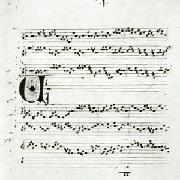 | Perotin
Viderunt Omnes
1198
REVIEWED: https://www.sputnikmusic.com/review/83427/Perotin-Viderunt-Omnes/ |
| 6 |  | Comtessa de Dia
A chantar m'er de so qu'ieu non volria
c. 1200
The troubadour tradition was not an exclusively male one, for there were many female troubadours (called "trobairitz") that we know of. As far as surviving works are concerned, however, only one trobairitz song survives: A chantar m'er de so qu'ieu non volria, written by the Comtessa de Dia (Countess of Die). The Comtessa's biographical story is indeterminate, with even her birth name being disputed (although Beatritz seems the likeliest answer), but we can suppose that her status as the member of a wealthy family helped her song outlast any of her contemporaries'. The song itself speaks from the perspective of a confused lover who has been mistreated by her male partner, expressing confusion while also asserting herself and warning him "that too much haughtiness makes many people suffer". |
| 7 |  | Walther von der Vogelweide
Palastinalied
c. 1220
Germany's form of courtly love emerged in the form of a genre called Minnesang ("love song"), believed to have originally evolved independently of the troubadour tradition but fell under its influence at some point in the late 12th century. The most famous practitioner of Minnesang, or "Minnesanger", was Walther von der Vogelweide (c. 1170 - c. 1230), from whom approximately 100 lyrics survive. Only one of his melodies is known, however: "Nu alrest lebe ich mir werde", also known as the Palastinalied, which is not even a love song at all, but rather new sacred lyrics that were likely set to an existing troubadour melody. As such, it is rather difficult to evaluate Walther's abilities as a composer, and as his are by far the most prominent Minnesang compositions, the musical genre itself remains somewhat a mystery. |
| 8 |  | Adam de la Halle
Jeu de Robin et Marion
1282
In addition to his songs (chansons), Adam de la Halle wrote polyphonic music, such as motets, and became one of the first composers on record to experiment with more complex sets of poetic forms: ballades, rondeaux, and virelais, which start to become more prominent in French music during the coming decades. His most famous piece, Le jeu de Robin et Marion ("Robin and Marion, A
Play with Music"), is a long-form play based around a secular love story, with featherweight, dancing melodies that may have invoked folk music traditions of the day. The play differs greatly from the theme of fin' amors, however; instead, it is an extension of the pastourelle form of poetry, in which the love in question is not unattainable, but is extant and threatened by an outside force, a rogue knight who wishes to kidnap the female love interest. |
| 9 |  | Guillaume De Machaut
Messe De Notre Dame
c. 1360
REVIEWED: https://www.sputnikmusic.com/review/83728/Guillaume-De-Machaut-Messe-De-Notre-Dame/ |
| 10 |  | Guillaume De Machaut
Douce Dame Jolie
c. 1360
Easily the most famous of Machaut's songs, "Douce Dame Jolie" (English: "sweet, lovely lady") is a prime example of a virelai - one of the three formes fixes that dominated French poetry/music in the fourteenth century. Machaut's usage of "courtly love" imagery is strong here, paired with a beautiful minor-key melody. Pinpointing the performance practices of this music is difficult, but given the piece's secular roots, we can assume that the singer (or singers, as the case may be) was accompanied by at least one instrument, and
perhaps an entire ensemble of instrumentalists. |
| 11 |  | Francesco Landini
Ecco la primavera
c. 1370
The Trecento period of Italian history was one defined by the region's destruction and subsequent rebirth in the fourteenth century, thanks to the catastrophic effects of the bubonic plague. The music of this era, while inspired in part by the music of the troubadours, generally entered a sphere unto itself by the later part of the century. Spearheading this was Francesco Landini (c. 1325 - 2 September 1397), a blind Florentine organist whose melodies were so beautiful that, as contemporary commenters stated, "hearts burst from [listeners'] bosoms". "Ecco la primavera" (trans.: "Behold, spring has come") is one of his most enduring pieces, a two-part ballata (a popular genre of music at the time) that makes use of some lovely contrasts and deploying of non-"perfect" intervals, such as thirds and sixths. |
| 12 |  | Guillaume Dufay
Nuper rosarum flores
25 March 1436
REVIEWED: https://www.sputnikmusic.com/review/83884/Guillaume-Dufay-Nuper-rosarum-flores/ |
| 13 |  | John Dunstable
Quam pulchra es
c. 1440
The most famous piece by John Dunstable, the first English composer of note and the one whose embodiment of the so-called "English countenance" (that is, heavily using thirds and sixths in his compositions) kick-started the Burgundian school of thought that ushered in music's Renaissance. "Quam pulchra es" (English: "how beautiful thou art") is a three-part motet with lyrics taken from the Bible's Song of Songs, merging the spiritual with the secular in a gorgeous description of intimacy. One thing worth noting is that despite the increase in triadic harmonies, the strong resolutions of phrases are still open, "perfect"
fifths or octaves, a sign that tradition has not been totally rejected in this new English style. |
| 14 |  | Unknown Composer
Missa caput
1440
The earliest-known setting of the Mass Ordinary to be arranged in a "cyclical" format - that is, each section of the mass shares the same underlying melody part, called a "cantus firmus". Attributed at times to Guillaume Dufay and John Dunstable, it's likely this was composed by an Englishman whose name has been lost to the sands of time, yet evidently possessed some notoriety in his day as the piece spawned a large quantity of imitators very quickly. |
| 15 |  | Guillaume Dufay
Missa se la face ay pale
1453
Dufay's most famous mass is one based off the motive of an early song of his, "Se la face ay pale" (English: "if my face seems pale"). The piece is Dufay's attempt at experimenting with the cyclical mass format, where that single motive is used as a linkage for each movement of the mass. |
| 16 | 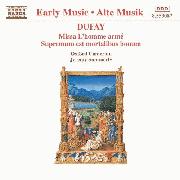 | Guillaume Dufay
Missa L'homme arme
c. 1460
Mass Ordinary settings of the tune "L'homme arme" were common in the 1450s and onwards, and this setting of Dufay's is among the most famous of these. The work allows each voice to move with an elegance that befits the melody, and the "Gloria" section in particular harkens back to the peaks and valleys present in the Aquitanian style of writing. |
| 17 |  | Johannes Ockeghem
Requiem
1461
The earliest polyphonic setting of the Requiem mass on record (a possible earlier mass by Dufay is lost), this mass (also known as the Missa pro defunctis) is an early example of a burgeoning late-15th century style of writing called "paraphrase masses". In these masses, the cantus firmus is taken from an existing sacred source, often from traditional plainsong chants, and the melody is embellished substantially. Ockeghem's requiem is believed to be incomplete, but one can still find unique elements in what does exist -
namely, a melancholy found in little other polyphonic music of the time, accentuated by the occasional chromaticism and florid lower voices. |
| 18 |  | Johannes Ockeghem
Missa prolationum
c. 1465
REVIEWED: https://www.sputnikmusic.com/review/84008/Johannes-Ockeghem-Missa-prolationum/ |
| 19 |  | Johannes Ockeghem
Missa Mi-Mi
c. 1475
One of the stand-outs from Ockeghem's oeuvre, this shorter mass setting is based off of a chanson the composer had written some years prior, "Presque transi". The bass part is a clear standout here, getting moments to shine such as a counterpoint feature with the melody in the Agnus Dei section. Ockeghem's expressiveness in his usage of dynamics is very pronounced in each movement. |
| 20 |  | Heinrich Isaac
Innsbruck, ich muss dich lassen
1485
One of the most famous melodies of the Renaissance era, "Innsbruck, ich muss dich lassen" (English: "Innsbruck, I must leave thee") was likely an early composition of Heinrich Isaac's and would go on to inspire the melodies for numerous other works, including sections of Bach's St. Matthew Passion. Lyrically, it is a mournful tale of a wayward traveller, bidding farewell to the town that he loves like a husband would his wife. |
| 21 |  | Josquin Des Prez
Missa L'homme armé super voces musicales
1490
REVIEWED: https://www.sputnikmusic.com/review/84051/Josquin-Des-Prez-Missa-Lhomme-arm%C3%A9-super-voces-musicales/ |
| 22 | 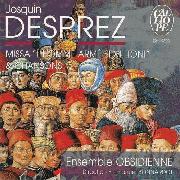 | Josquin Des Prez
Missa L'homme armé sexti toni
c. 1500
Subtitled for the six tones that represent the Guidonian hexachord (the foundations of sight-singing and modern choral performance generally), this is generally the less-regarded of the two L'homme arme masses, much more straight-forward in its construction and less interesting dynamically. Even still, it's a worthwhile listen for the sake of contrasting those two masses, and Josquin loves his canons so those are always a given, enjoyable to hear. |
| 23 |  | Antoine Brumel
Missa Et ecce terrae motus, "The Earthquake"
c. 1500
Most famous of his masses, Antoine Brumel's "Earthquake" mass is written for a staggering 12 voices, which at face value sounds extremely excessive. Maybe so, since it was the perfect time for such things, but the piece avoids being unlistenable because all of the parts work in concert without drawing too much attention to any individual one - one of the most typically "ethereal" works of the era. |
| 24 | 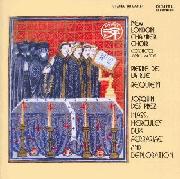 | Pierre de la Rue
Requiem
c. 1500
Another early example of a Requiem mass, this one more complete than Ockeghem's and arguably more befitting of the darkness that the text represents. la Rue's trademark contrabass lines are in evidence here, bottoming out at around a low B (B1) which was an absurdly low range for the time and very difficult to replicate even today. |
| 25 | 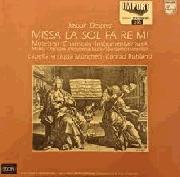 | Josquin Des Prez
Missa La sol fa re mi
1502
A mass based on wordplay, namely a play on the expression "Lascia fare mi" (English: "let me do it"), which was a common Italian expression at the time. Josquin converts the phrase into a motive based on solfege syllables, and that motive repeats itself over 200 times in various different forms (sometimes as-written, sometimes in retrograde, sometimes both in succession). Very mellow, with a "Credo" movement that uses a lot of minor thirds to create a somber sort of atmosphere. |
| 26 | 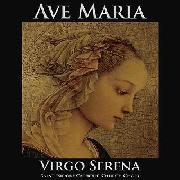 | Josquin Des Prez
Ave Maria... Virgo serena
1502
Probably the most famous singular composition of Josquin's, this piece is credited, at least in part, with revitalizing interest in the motet as a genre during the sixteenth century, after the spread in masses' popularity had eclipsed that of shorter pieces. The melody is piercing in its beauty, all four voices playing off each other in canon/canon-like interactions. There is no real question of the mood Josquin is trying to convey: it is ethereal in the most magical sense, without any strings attached and yet all the while carrying a depth, a sense of significance in its harmonies that is indescribable. Not much can be said beyond that: it is perhaps the best starting point for anyone interested in Renaissance choral music, and for as expressive as Josquin is known to get in his writing, this work channels a very spiritual set of emotions that even only a select few of Josquin's masses really came close to accomplishing. |
| 27 |  | Josquin Des Prez
Missa Hercules dux Ferrariae
1503
An early example of a technique called soggetto cavato (English: "carved-out subject"), where the music is based on a cantus firmus based on individual solfege symbols, this piece is a quirky exercise based on the name of the then-Duke of Ferrara, Josquin's patron at the time. |
| 28 |  | Jacob Obrecht
Missa Maria zart
1504
One of the longest surviving Renaissance masses, this late-career work of Obrecht's contains 51 subsections in its 5 movements, taking upwards of an hour to perform. Ambitious and admittedly still quite melodic in the midst of that technical ambition, it is nevertheless easy to see how composers began shifting towards a more stripped-back approach following the deaths of Ockeghem, Obrecht and their cohorts. |
| 29 |  | Alexander Agricola
Missa In myne zyn
c. 1505
Another of the late-period Burgundian composers, Alexander Agricola is also remembered for the elaborate structures of his compositions. The Missa in myne zyn is especially brim-filled with motion, to the point where it begins to suffocate under its own complexity. It is also an incomplete mass setting, with no "Kyrie" section having survived. |
| 30 |  | Jacob Obrecht
Missa Sub tuum praesidium
c. 1505
One of Obrecht's most inventive masses, this piece starts off with 3 voices for its "Kyrie" movement and adds a new voice with each new section, culminating in a 7-voice "Agnus Dei". Imitative of Ockeghem in both its expressive and far-reaching technical aspirations, the piece is indicative not just of why Obrecht was popular in his time, but of why his style quickly became outmoded in favor of the next generation of composers. |
| 31 | 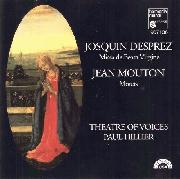 | Josquin Des Prez
Missa de Beata Virgine
c. 1505
For a long while, this was the most famous of Josquin's late-career masses, full of contrapuntal harmonic lines and curiously-administered arrangings of the voices. Despite its somber tone, moments in this piece are unusually bombastic for Josquin, and each movement is based on a traditional plainsong melody - perhaps more of a callback than a look to the future. |
| 32 |  | Josquin Des Prez
Missa Malheur me bat
c. 1505
A relatively minor Josquin mass, this one (English translation: "misfortune beats me") has a particularly florid Agnus Dei section and is one of the rare masses of his that contains six individual parts - more of the subtle complexities that define his style. |
| 33 |  | Arnolt Schlick
Salve Regina
c. 1512
Arnolt Schlick was among the first noteworthy composers for keyboard instruments, at least of whose works have survived. His setting of the Salve Regina hymn, among the most popular Renaissance keyboard works, gives a great insight into how different the writing was back in the day; very choral-like, slow-moving contrapuntal lines that frankly are not "virtuosic" in any sense. |
| 34 |  | Johannes Prioris
Requiem
1514
The only especially noteworthy composition of Johannes Prioris, this early Requiem betrays a strong influence from Italian choral writing. Much of the harmonies are written as block chords, moving in unison rather than each voice working at its own pace, which was found more often in the Burgundian writings of the day. |
| 35 |  | Josquin Des Prez
Missa Pange lingua
c. 1514
REVIEWED: https://www.sputnikmusic.com/review/84078/Josquin-Des-Prez-Missa-Pange-lingua/ |
| 36 | 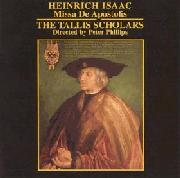 | Heinrich Isaac
Missa de Apostolis
c. 1515
Isaac's main success seems to have been in his motets and shorter pieces, but this is a nice mass setting all the same, contrapuntal without exercising itself too unnecessarily in that regard. |
| 37 |  | John Taverner
Missa Gloria tibi Trinitas
1526
A strong English mass from the period, this is John Taverner's best-known work, notable for featuring no Kyrie section. Instead, the Kyrie is "troped", added in as its own melismatic phrase without any added harmonies; in effect, it relegates the Kyrie to an introductory role amidst the greater piece. |
| 38 |  | Cristobal de Morales
Officium defunctorum
1528
A nice setting of the Office of the Dead, with lots of homophonic chord movements used in a way that seems to be present in a lot of Spanish Renaissance compositions. |
| 39 |  | Jean Richafort
Requiem in memoriam Josquin des Prez
1532
The fact that Jean Richafort's most famous work is a tribute to Josquin des Prez is unsurprising; Richafort studied under Josquin for some time, and a lot of his style is heavily indebted to stylistic changes Josquin helped spearhead. But for being relatively forgotten as a composer since his day, Richafort's Requiem mass is an emotional punch in the gut unlike most other pieces you will hear from that era. The piece uses a lot of grand dynamic changes in its contrapuntal settings, as if to imitate the sound of a sea of individuals sobbing, lamenting the loss of a massively significant musical figure. The lamentations are all very individualized, however, as the piece uses very little in the way of homophony in favor of each voice getting its own melodic figures. Just outstanding. |
| 40 |  | Adrian Willaert
Missa Christus resurgens
c. 1535
One of the great early writers of madrigals, Adrian Willaert's mastery seems to have been with shorter compositional forms as opposed to masses - this, his most famous mass (based off a Richafort melody), doesn't stand out particularly, despite having some beautiful melodic parts. |
| 41 |  | Nicolas Gombert
Magnificat primi toni
c. 1540
Gombert's first Magnificat is a splendid piece - probably the most famous of his as well, and for good reason. As is typical of the magnificat format, the piece is written as a collection of short motets, the last of which builds up to a truly overwhelming climax. |
| 42 | 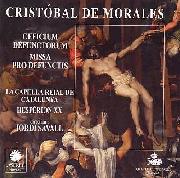 | Cristobal de Morales
Missa pro defunctis
1540
A piece so morose that it moves at a snail's pace, this is probably the most famous work of Spain's original internationally-renowned composer. It demonstrates the homophonic textures that defined late-period Cristobal do much, and performances of it run on the longer wide compared to most pieces of the period, generally in excess of 45 minutes. |
| 43 |  | Cipriano de Rore
Missa Praeter rerum seriem
c. 1550
Another composer more known for madrigals than masses, Cipriano de Rore still allows some of his trademark chromaticism into this work, probably his most famous sacred piece. |
| 44 |  | Cipriano de Rore
Passio
1557
An early choral setting of the St. John Passion. More important in the context of the genre than it is indicative of Cipriano's other work. |
| 45 | 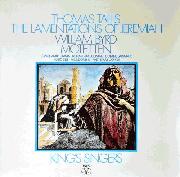 | Thomas Tallis
Lamentations of Jeremiah the Prophet I
1560
One of the most popular works of the most popular composer of the Elizabethan era, this setting of the Lamentations of Jeremiah features some of the hallmarks of the era: very syllabic, punchy singing, enunciated to a fine degree and rarely pairing more than one note to a syllable. What florid sections there are exist sparingly, as clear contrasts to the main body of the work. Textually dense, these English compositions were. |
| 46 |  | Giovanni Pierluigi da Palestrina
Missa Papae Marcelli
1562
REVIEWED: https://www.sputnikmusic.com/review/84195/Giovanni-Pierluigi-da-Palestrina-Missa-Papae-Marcelli/ |
| 47 |  | Thomas Tallis
Tunes for Archbishop Parker's Psalter
1567
A collection of nine brief Psalm settings intended for publication in a psalter (psalm collection) written by English theologian Matthew Parker. The settings are all very brief, but the melodies included are rich, ranking among the most popular English melodies from this period. |
| 48 |  | Roland de Lassus
Missa osculetur me
c. 1570
A generally strong Lassus mass written for two separate choirs, this piece has a rather unique Credo section that sticks out noticeably compared to all the other movements - parts of it seem almost isorhythmic, a sort of throwback to medieval polyphony. It's a credit to Lassus's compositional versatility that he can pull off such an imitation as well as he does. |
| 49 |  | Thomas Tallis
Spem in Alium
1570
Thomas Tallis takes the unwieldy 12-part arrangement of Brumel's Earthquake mass and raises him to a staggering 40 voices - 8 different choirs, each singing 5 distinct parts. It's a remarkable achievement just as much as it is a rather atypical work for Tallis, yet critics both of the time and after the fact have referred to it as among the greatest early English choral works. One would be hard-pressed to disagree with that assessment. |
| 50 |  | Tomas Luis de Victoria
O magnum mysterium
1572
A very warm, beautiful setting of this traditional responsorial chant, this is among Victoria's most famous motets and was used as the basis of a mass composed some 20 years later. The "Alleluia" section at the end is a creative coda to the piece, very staccato and making use of a very nice inner voice suspension on the final chord. |
| 51 | 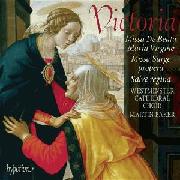 | Tomas Luis de Victoria
Missa De Beata Maria Virgine
1576
Another pleasant early Victoria mass with more than a shade of melancholy to it. |
| 52 |  | Tomas Luis de Victoria
Missa gaudeamus
1576
A somewhat early Victoria mass that has a bit of a stilted flow to it, but balances this with many lovely minor-key passages. |
| 53 |  | Roland de Lassus
Requiem
1578
A strong, if perhaps not a stand-out Requiem setting. |
| 54 |  | Tomas Luis de Victoria
Missa pro defunctis
1583
Sort of a dry run for what's to come, a four-voice Requiem that Victoria would revisit and rearrange 20 years later in six-voice form. |
| 55 |  | Tomas Luis de Victoria
Missa Surge propera
1583
Very dynamic, this mass feels significantly more matured compared to Victoria's earlier works - there's a crushing solemnity to the work, especially in the closing Agnus Dei movement that tugs at the listener's heartstrings. |
| 56 |  | Roland de Lassus
Psalmi Davidis pœnitentiales
1584
A collection of seven motets set to the seven Penitential Psalms of David, the setting of De profundis is easily the most famous piece here, but all of these are fantastic. Very moving polyphony that packs an emotional wallop with its soaring high-register lines, a worthwhile listen either in parts or as a collective. |
| 57 |  | Tomas Luis de Victoria
Tenebrae Responsories
1585
A set of 18 four-voice motets written for the Matins traditions of Thursday, Friday and Saturday of the Catholic Holy Week. |
| 58 |  | Giovanni Pierluigi da Palestrina
Missa sine nomine a 6
c. 1590
Bit of a nondescript mass overall apart from a lively Credo, yet historically important for being an inspiration for Bach's Mass in B minor. |
| 59 | 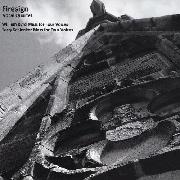 | William Byrd
Mass for Four Voices
1593
A beautiful and elegant initial entry to Byrd's trilogy of masses, using a mixture of textural effects to make it sound almost chameleonic in its styling. |
| 60 |  | William Byrd
Mass for Three Voices
1594
Probably the least of Byrd's mass trilogy, not just because it has less parts to work with, but because the overall structure is thrown off-kilter by a confusingly brief Kyrie. Still gorgeous at its peaks, though. |
| 61 |  | William Byrd
Mass for Five Voices
1595
Five voices isn't necessarily better than four, but this is still a nice piece with some technically challenging lines (although, like the three-voice mass, the Kyrie section feels rushed). |
| 62 |  | Roland de Lassus
Lagrime di San Pietro
1595
20 madrigals + one motet, a collection of madrigali spirituali ("spiritual madrigals") that was the last thing Lassus ever worked on before his death. Knowing this, it would seem to make sense that the work feels like a reflection on his composing up to this point, a summary of his history and stylistic changes. Certainly the crowning achievement of his career, it's a helluva way to close, and also very easy to consume both in parts and on its own. |
| 63 |  | Jacopo Peri
Euridice
6 October 1600
Perhaps time has rendered this, the earliest-surviving complete opera, a bit ham-fisted in its thematic treatments. But credit must go to Peri, a prolific composer despite his style growing out-of-fashion quickly, for helping establish operatic tropes like the contrast between recitative (speech-like singing) and arias (dramatic singing) and the soloist/ensemble contrast so early on. |
| 64 |  | Tomas Luis de Victoria
Officium Defunctorum (Requiem)
1603
Written for his recently-deceased patron, the former Holy Roman Empress Maria, this piece is Victoria's high-water mark, the last he wrote during his lifetime and the summation of his style. Emotionally turbulent, the voices weep and wail with their rising and falling dynamics. It's emblematic of Victoria's mysticism as a composer while never feeling too foreign; it is, unquestionably, a work drenched in humanity. |
| 65 | 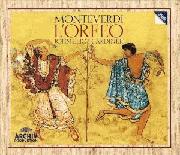 | Claudio Monteverdi
L'Orfeo
24 February 1607
Already a widely-known composer of madrigals, Claudio Monteverdi wrote his first opera in 1609, and it is a pivotal one in the early history of the genre. The piece modernized the setting of Peri's Euridice, staying truer to the original story and adding a more diverse array of instrumentation to the proceedings, including brass and winds. Such was the vastness of its popularity that it remains semi-regularly performed up to the present day. |
| 66 |  | Manuel Cardoso
Requiem
c. 1610
The Portugese equivalent to Palestrina, this is a very nice Requiem that falls under the radar compared to more popular versions. |
| 67 | 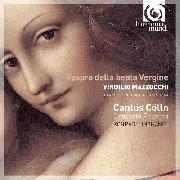 | Claudio Monteverdi
Vespro della Beata Vergine
1610
REVIEWED: https://www.sputnikmusic.com/review/85232/Claudio-Monteverdi-Vespro-della-Beata-Vergine/ |
| 68 |  | Carlo Gesualdo
Sesto libro di madrigali
1611
Gesualdo's works are interesting in that they raised eyebrows across the scene when they were first published, were promptly forgotten about after his death, then revived over 300 years later by the serialists (Schoenberg and Stravinsky, particularly). Even if these madrigals can't be considered "atonal" per se, they certainly stretch the boundaries of tonality in a manner not seen before and very infrequently seen afterwards until the 20th century. Listen to "Moro, lasso, al mio duolo" (English: "I die, alas, in my suffering") for the end-stage Renaissance version of proto-Schoenberg. |
| 69 |  | Gregorio Allegri
Miserere
c. 1630
This work, written for two choirs and by a wide margin the most famous of Allegri's, gained a mythical stature thanks to its only being performed at the Sistine Chapel during the services of Holy Week. A ban on transcriptions of the work existed until the late eighteenth century, and even then certain performance practices unique to the Chapel have been lost to time. Nevertheless, the work is gorgeous, especially the haunting soprano line that peaks at their high C. |
| 70 |  | Heinrich Schutz
Musikalische Exequien, Op. 7
1636
A requiem in all but name, the first of its kind to be published in the German language (using predominantly Lutheran texts). |
| 71 | 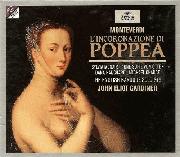 | Claudio Monteverdi
L'incoronazione di Poppea
1642
There are some questions about whether this, Monteverdi's last opera (and last work written during his lifetime), was entirely written by him. Whether or not it was, there's no doubt that it advances the operatic form a considerable distance compared to where it was at the time of L'Orfeo. 28 different vocal parts are featured here, and the radical textual choice (a scandalous love affair that has caused ethical debates to this day) shows how opera was already expanding from the precedents that its theatrical predecessors, the Greek dramatists, had set millennia previously. Quite simply, one of the most daring pieces of music composed to this point, directing the world to the 18th century over 50 years before it had even started. |
| 72 |  | Denis Gaultier
La Rhetorique des dieux
c. 1650
A collection of lute pieces written by Gaultier, one of the preeminent lute composers of the late seventeenth century. There is a clear maturation in the writing of Gaultier compared to what, say, Dowland was doing some 50 years prior - the melancholic melodies are filled in by more intricate finger-picking patterns. |
| 73 |  | Jean-Baptiste Lully
Plaude laetare Gallia
1668
Written as a dedication for Louis XIV's first son, this is an exemplary example of Lully's grand motet writing: brash string + brass sections accompanied with a basso continuo, augmented by a vibrant choir. |
| 74 |  | Heinrich Ignaz Franz Biber
Mystery Sonatas
1676
A lovely collection of sonatas that sounds at least 50 years ahead of its time. Biber was not generally considered among the elite Baroque composers, at least until this work was discovered (around 1905), which leaves him (like Bach to come) as a more contemporary discovery and a more-appreciated composer today than he was in his day. |
| 75 | 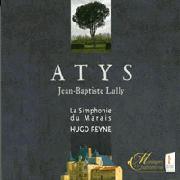 | Jean-Baptiste Lully
Atys
10 January 1676
Lully's operas, despite nearly always being based off tragedies, retain a brightness about them that sets them apart from Italian styles like opera seria that were growing so popular in the day. Unfortunately, this leaves Lully as more of a sidenote to operatic development rather than a leader, but his stuff is worth listening to all the same. |
| 76 |  | Jean-Baptiste Lully
Te Deum
1677
Another stellar Lully motet, this is longer than his usual works of the genre and spends more time in the slower sections than a lot of his other pieces do. |
| 77 | 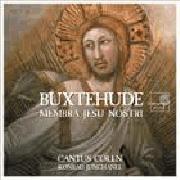 | Dietrich Buxtehude
Membra Jesu Nostri, BuxWV 75
c. 1680
An atypical work for the typically keyboard-centric Buxtehude, a relatively important work for being the first Lutheran oratorio, a large-scale sacred work featuring orchestra, choirs and soloists alike. Additionally, it just probably the most musically-interesting oratorio of any faith to have been composed during this time, a testament to Buxtehude and his affinity for voice leading/arranging. |
| 78 |  | Johann Pachelbel
Canon and Gigue in D
c. 1680
It's difficult to call Pachelbel's canon one of the most enduring pieces in classical music's history, because the piece lounged entirely in obscurity until the late 1960s, after which it exploded in popularity. Nevertheless, its simplicity is its virtue, undoubtedly. It builds upon its themes from the ground up, very methodically, and it doesn't waste time getting from place to place, either. A singular piece from Pachelbel both in fame and style, as his keyboard works are much more well-known than his chamber music, generally. |
| 79 |  | Jean-Baptiste Lully
Armide
15 February 1686
Truly an excellent opera from Lully, including a superb soprano part in that of the titular character. Per Lully's standard, heavy emphasis on instrumental interludes that would have included dancing of some kind. |
| 80 |  | Robert de Visee
Suite No. 9 in D Minor
c. 1686
Nice guitar suite from one of Baroque-era France's premiere composers of the style. |
| 81 |  | Henry Purcell
Dido and Aeneas, Z.626
July 1688
A vibrant English opera - well, mini-opera, as there is much less musical material despite sticking to a three-act structure. Purcell's light burnt brightly, if briefly (dying at the young age of 36), and this is a high-point of his career indubitably. |
| 82 |  | Dietrich Buxtehude
Magnificat Primi Toni BuxWV 203
c. 1690
A unique organ piece for Buxtehude in that it is based around sacred texts and thus is structured more like a chorale than anything else. |
| 83 |  | Dietrich Buxtehude
Prelude in G minor BuxWV 149
c. 1690
A terrific two-hand showcase, perhaps Buxtehude's best in that vein. It's easy to hear the influence on later German composers (read as: Bach) in works like this. |
| 84 |  | Henry Purcell
Dioclesian, Z.627
May 1690
Incidental music composed in a way that garnered this play the label "semi-opera" - any singing is done only by supporting cast members, with the main characters only speaking. Not one of Purcell's better works in
that realm, his melodies get more interesting later on. |
| 85 |  | Henry Purcell
The Gordian Knot Untied, Z.597
1691
Terrific overture to this one, another of the myriad incidental musics Purcell would compose. |
| 86 |  | Henry Purcell
King Arthur, Z.628
May 1691
Not quite the equal of Dido & Aeneas, but probably the strongest drama Purcell did afterwards, with a captivating plot that takes a left-field look at the Arthur mythos, complete with some fantastic ensemble works. |
| 87 |  | Marc-Antoine Charpentier
Te Deum, H. 146
1692
The most famous piece by France's most chameleonic composer of the time, even including Lully. Contains dramatic contrasts in a way that Lully's grand motets sorely lack. |
| 88 |  | Henry Purcell
Odes for St. Cecilia's Day - Music for Queen Mary
1692
An early tune of Purcell's that he turned into a sort of song cycle dedicated to Cecilia, the patron saint of musicians. |
| 89 |  | Henry Purcell
The Fairy Queen, Z.629
2 May 1692
A very bright Purcell "semi-opera", and perhaps his most famous, being based off the story of Shakespeare's Midsummer Night's Dream. Very vibrant music, spirited in a way much of Purcell's other works don't match. |
| 90 | 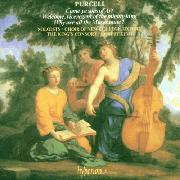 | Henry Purcell
Come Ye Sons of Art, Z. 323
1694
A grand work written for the birthday of Queen Mary of England, the sixth and final ode of its kind as Mary would die at the end of the year. In its own way, it serves as a forebearer to the composer's own death the following year. |
| 91 |  | Henry Purcell
The Married Beau, Z.60
1694
More incidental music, in this case incidental and nothing but. |
| 92 |  | Henry Purcell
The Virtuous Wife, Z.611
1694
Strong later-career arranging from Mr. Purcell here. |
| 93 |  | Henry Purcell
Abdelazer, Z.570
1695
More incidental music - interesting that contemporary recordings choose to include some of the spoken text. |
| 94 |  | Henry Purcell
Music for the Funeral of Queen Mary, Z.860
1695
Beautiful processional music for the funeral of Queen Mary, and later used for Purcell's own funeral just some months later. |
| 95 |  | Henry Purcell
The Indian Queen, Z.630
June 1695
Only a partially complete semi-opera, which makes it sound like there's hardly any music to speak of. It's not quite true, and at any rate, the music that's there is quite nice, actually. |
| 96 |  | Johann Pachelbel
Hexachordum Apollinis
1699
A collection of arias with variations that may have been the most well-known thing Pachelbel put out during his lifetime. Given how certain other keyboard composers would experiment with variations on themes in the future, the importance of this piece should not be lost on anybody. |
| 97 | 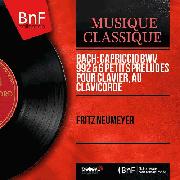 | Johann Sebastian Bach
Capriccio in B-flat major, BWV 992
1704
Fledgling Bach here - 19 years old at the time of writing this, supposedly as a tribute to his brother who had left the country. A nice listen, more interesting than one might expect a teenager's compositions to sound like. |
| 98 |  | Jean-Philippe Rameau
Premier Livre de Pièces de Clavecin
1706
A great collection of harpsichord (clavecin) pieces that was important in Rameau making his name as an important harpsichord composer of the time. |
| 99 | 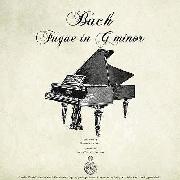 | Johann Sebastian Bach
Fugue in G minor
1707
A statement piece, coupling one of Bach's most recognizable melodies with an interplay between hands and the minor-key counter-melody that overwhelms you in power and dissonance. Absolutely staggering to think that he was only 22 when he wrote this. |
| 100 |  | Johann Sebastian Bach
Toccata and Fugue in D minor, BWV 565
c. 1707
How something so wildly experimental and with so much dissonance could have been composed in the first decade of the 1700s is beyond what I can properly express. The intro to the toccata alone needs no introduction or further clarification - you've heard it, you've seen it used in every scary movie scene imaginable, you've already formulated thoughts on it. The fugue is excellent in its own right, too. The piece stands out from its contemporaries so wildly that it seems almost too good to be true - was the toccata simply better preserved or written down in more detail than others of the era, or was it simply that much more impactful? Impossible to really say, but it's a classic for a reason. |
|
